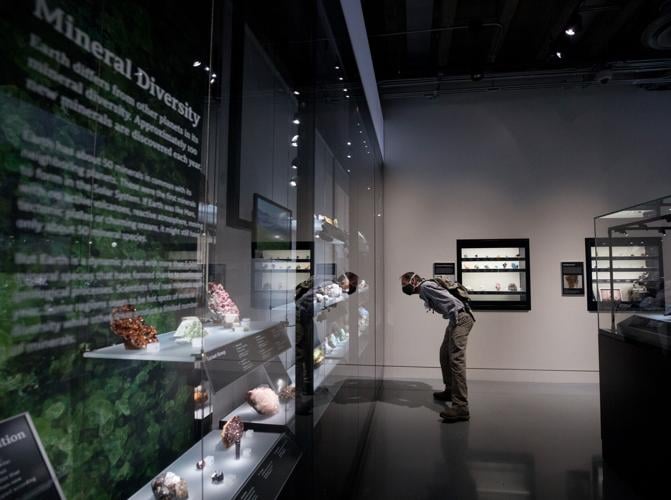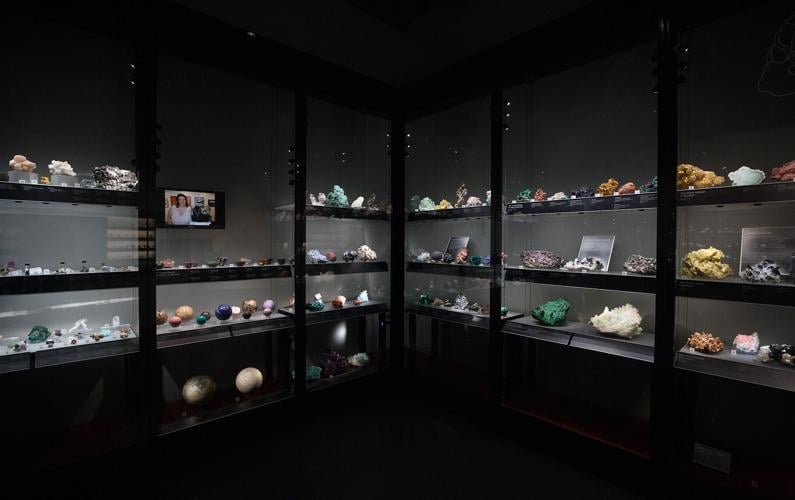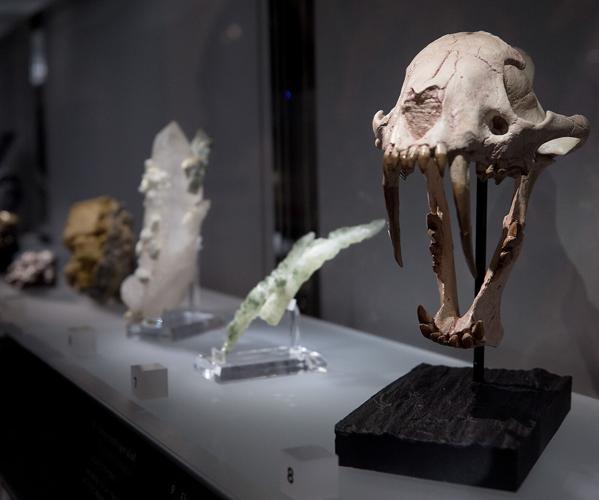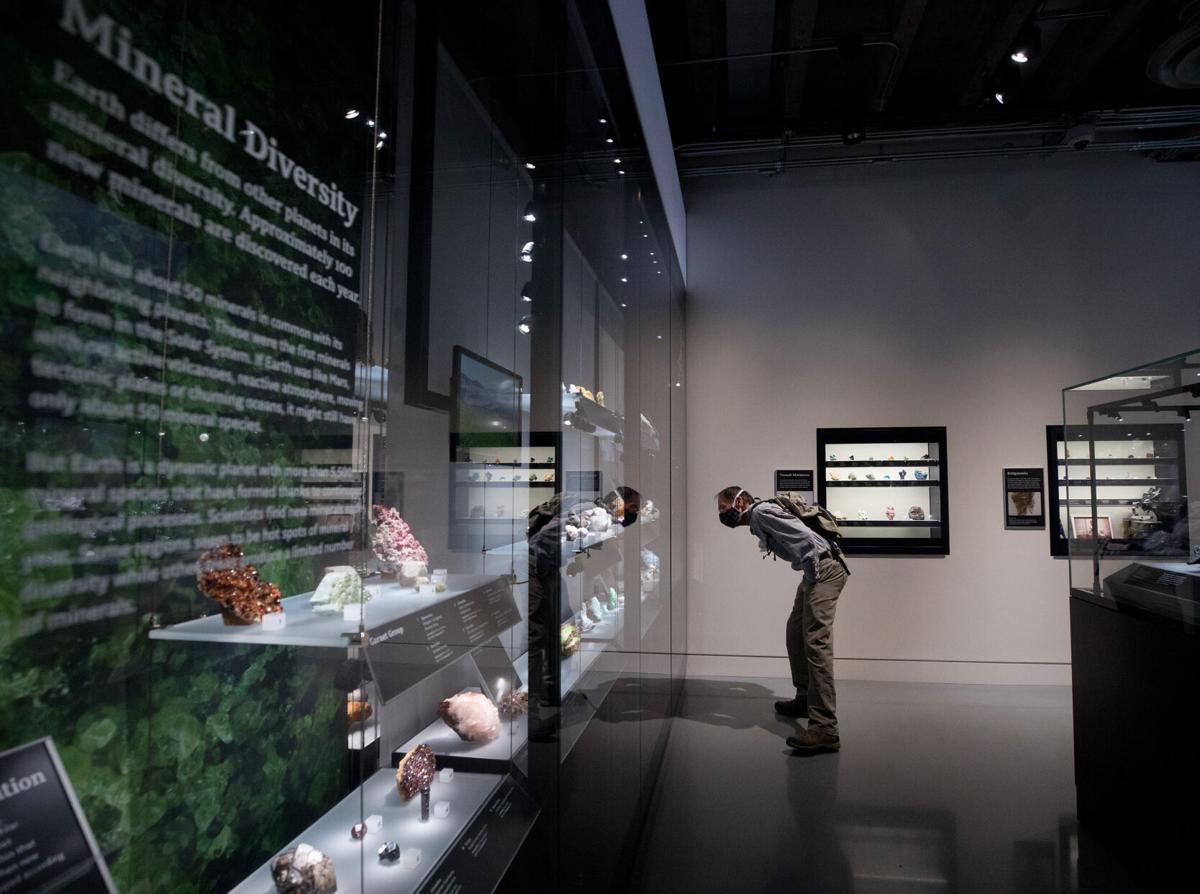You could spend the entire day wandering the galleries of the University of Arizona Alfie Norville Gem & Mineral Museum and still manage not to see everything.
Located in a section of the old Pima County Courthouse downtown, the museum has an estimated 3,000 specimens on display, pulled, sometimes literally, from every corner of the Earth, spread across 12,000 square feet of space.
A massive quartz cluster, one of the largest intact clusters ever mined in Arkansas, greets guests as they walk into the lobby.
There’s an Arizona Gallery with a larger-than-life recreation of the Copper Queen Mine in Bisbee, complete with interactive schematics; a touch-and-feel zone where visitors can run their hands along different mineral samples; and a 116.76-carat Tsavorite Garnet dubbed the Lion of Merelani, on loan from the Smithsonian.
The museum is modern and state-of-the-art and has a little bit of everything, according to Elizabeth Gass, its exhibit specialist.

Amateur collectors can have their minerals on display at the Alfie Norville Gem & Mineral Museum.
“We’ve had people spend an hour in the first gallery, before they realize that is only a third of what we offer,” Gass said. “It is about an hour-and-a-half trip to walk through on average. But that is really just glancing at things.”
The museum opened its doors last July, but will have its first real moment in the sun when the Tucson Gem, Mineral & Fossil Showcase ramps up later this month.
Pre-pandemic, the annual event, which generally runs through mid-February, brought an estimated 65,000 people to Tucson each year. That number may be smaller in 2022 due to surging COVID numbers, but many of the shows are still happening after canceling in 2021 because of the pandemic.

A Tourmaline necklace, from the Somewhere in the Rainbow collection, is on display at the Alfie Norville Gem & Mineral Museum.
The museum, which began construction at the courthouse in 2018, is named after Alfie Norville, a co-founder of the Tucson Gem and Jewelry Exchange show held each year as part of the showcase.
“She was a big jewelry lover,” Gass said. “She was interested in making Tucson a big hub for minerals, gems and jewelry. I believe they succeeded.”
The 3,000 specimens on display at the museum are a mix of pieces on loan and from the university’s own collection of more than 20,000 pieces. Until it was moved over, much of the collection resided at the Flandrau Science Center and Planetarium on the UA campus.
Gass said the goal is to rotate about 20% of the museum’s gallery pieces per year.

A trilobite, far left, is on display with other fossils at the Alfie Norville Gem & Mineral Museum.
“In the museum industry, that is an industrious percentage of change,” Gass said.
Gass said the museum is looking to attract a variety of visitors.
“We want to appeal to everybody,” she said. “To create an environment where people who have been in the field for a long time would be interested, but also offer ways for people who might not know a lot about it to learn more.”
The museum is just one stop that folks can make as they tour the city’s many Gem, Mineral & Fossil Showcase shows over the coming weeks.

A sabre-tooth tiger skull, far right, is on display at the Alfie Norville Gem & Mineral Museum, inside the historic Pima County Courthouse.
You can find a full list of events and a downloadable app at visittucson.org.
In the meantime, here are some of the highlights.
You can’t attend the Tucson, Gem, Mineral and Fossil Showcase without paying a visit to the event that started it all: the Tucson Gem & Mineral Show, which is set to take place Feb. 10-13.
Laying claim to being the “largest, oldest and most prestigious gem show in the world” on the Tucson Gem and Mineral Society website (tgms.org/show), the four-day event returns after being canceled last year due to the pandemic.
No need to fret over inclement weather. The show is held inside the Tucson Convention Center, 260 S. Church Ave., with lectures and seminars, more than 250 retail dealers and 80 exhibits in a fluorescent mineral pavilion relating to this year’s theme, “The Show That Glows.”
The event runs from 10 a.m. to 6 p.m. Feb. 10-12 and 10 a.m.-4 p.m., Feb. 13. Tickets are $13.
The 22nd Street Mineral, Fossil, Gem & Jewelry Show, running Jan. 27 to Feb. 13, is a fan favorite, in part because admission is free (although parking will run you $5 on weekdays and $10 on weekends.)
Located at 600 W. 22nd Street, on the east side of Interstate 10, the show (website: 22ndstreet.show) features dealers specializing in just about everything from dinosaur skeletons to beads to meteorites.
When you are ready to eat, the show has more than 10 food trucks to feed you on-site, including Culinary Graduate, Jozarelli’s Italian Street Food, the Curry Pot and Bubba-Que.
Grab a bite, then head to the other side of Interstate 10 to visit the shows taking place in the many hotels that line the frontage road, then hop on the highway to get to another free and popular show, the Kino Gem & Mineral Show, at the Kino Sports Complex, 2500 E. Ajo Way, also happening Jan. 27-Feb. 13 (as-shows.com/kino-gem-show)
You can explore an entirely different continent without leaving Tucson during the Gem, Mineral & Fossil Showcase at the African Art Village, 279 S. Linda Ave., right around the corner from the MSA Annex, downtown.
Like many of the other show runners last year, African Art Village founder and coordinator Charlotte Mack opted not to participate in 2021.
“It was too soon,” Mack said.
But, she added, that has only made people more enthusiastic about its big return, Jan. 29-Feb. 13.
“People have contacted me about the show this year, made reservations to come here based on the African Art Village,” she said. “My show is outside. That should make it safer for everyone.”
Specializing in artisans from West Africa, countries like Mali, Ghana and Gambia, the village will include more than 120 vendors, selling everything from artwork to textiles to masks.
Mack said, pre-pandemic, beads for jewelry making had been top sellers.
“People are making their own jewelry,” Mack said. “I’ve had people contacting me during the pandemic, asking me for information about our bead sellers.”
The African Art Village runs 9 a.m.-6 p.m. daily. Call 520-869-7895 for more information.
Photos of the Tucson Gem, Mineral, and Fossil Showcase through the years
Tucson Gem, Mineral, and Fossil Showcase
Updated
The 1967 show at the Tucson Rodeo and Fairgrounds drew a modest crowd. After its 1955 beginnings in a school auditorium, the Tucson Gem and Mineral Society moved its annual show to the Quonset hut at the Tucson Rodeo and Fairgrounds on South Sixth Ave., at Irvington Road.
Tucson Gem, Mineral, and Fossil Showcase
Updated
Exterior of Quonset on South Sixth Ave site of Tucson Gem, Mineral, and Fossil Showcase, 1956-1971.
Tucson Gem, Mineral, and Fossil Showcase
Updated
Louise Feller of Seattle looks for some gems at the Tucson Convention Center in 1991.
Tucson Gem, Mineral, and Fossil Showcase
Updated
Dealers preparing their displays near I-10 and Congress in 1991.
Tucson Gem, Mineral, and Fossil Showcase
Updated
Mike Donovan of Texas looks at a 20-foot Pleisiosaur at the Tucson Convention Center in 1991.
Tucson Gem, Mineral, and Fossil Showcase
Updated
Tucson Convention Center full of exhibitors and buyers in 1993.
Tucson Gem, Mineral, and Fossil Showcase
Updated
Nickolai B. Kuznetsov and Alexander O. Agafonoff from Russia prepare their exhibit in a room at the Best Western Executive Inn in Tucson in 1993.
Tucson Gem, Mineral, and Fossil Showcase
Updated
Dilip Shah of New York City conducts business while laying on his bed at the Discovery Inn in 1994.
Tucson Gem, Mineral, and Fossil Showcase
Updated
David Velk checks out some of the various Trilobites which were only one of many fossil exhibits at the gem and mineral showcase Fossil Exhibit at the Executive Inn in 1995.
Tucson Gem, Mineral, and Fossil Showcase
Updated
The first public day of the Tucson Gem & Mineral Society Show was a busy affair at the Tucson Convention Center in 1997.
Tucson Gem, Mineral, and Fossil Showcase
Updated
Gem show vendor Albert Volker, sits with his sizable collection of smokey quartz in 1998, mined by himself on his ranch in Montana. Vollker was one of the last participants doing business as most others packed up to leave.
Tucson Gem, Mineral, and Fossil Showcase
Updated
Tom Moore. Editor of the Mineralogical Record magazine, shows this drawer which has Apatite, Pyromorphite, Mimetite, and Vanadinite in 2005.
Tucson Gem, Mineral, and Fossil Showcase
Updated
Colored glass jewels glimmer with at least some of the sparkle of their rarer counterparts at the Globe-X Gem & Mineral show at the Days Inn Downtown in 2007.
Tucson Gem, Mineral, and Fossil Showcase
Updated
Yurie Ishizaka of Tokyo looks in display cases during the first day of the Tucson Gem and Mineral Show at the Tucson Convention Center on February 10, 2011.
Tucson Gem, Mineral, and Fossil Showcase
Updated
Rocks, shells, and minerals for sale at the Miner K booth at the Tucson Gem and Mineral Show at the Tucson Convention Center in 2011.
Tucson Gem, Mineral, and Fossil Showcase
Updated
Naoki Ninomiya examines a piece of Smithsonite from Mexico by putting it up to the light during the Arizona Mineral and Fossil Show as part of the 58th Annual Tucson Gem, Mineral, and Fossil Showcase at the Hotel Tucson City Center in 2012.
Tucson Gem, Mineral, and Fossil Showcase
Updated
Mike Anglin from Mission Viejo, Calif looks at agate from Argentina at the STPGM booth during the opening day of the Tucson Gem and Mineral Show at the Tucson Convention Center in 2012.
Tucson Gem, Mineral, and Fossil Showcase
Updated
A variety of Rose Quartz, Crystals, Tourmaline and Red Jasper glisten in the sunlight at Jay Gems and Minerals as they are on display at the Riverpark Inn at 350 South Freeway for the upcoming Tucson Gem, Mineral and Fossil Showcase on Jan. 23, 2017.
Tucson Gem, Mineral, and Fossil Showcase
Updated
Robert Tapia, left, and Jason Fox, warehouse manager at Superb Minerals, set up for the annual Tucson Gem, Mineral and Fossil Showcase which begins on January 26 and ends February 11. The store located at 1243 N. Main Ave sells zeolites from India. January 02, 2018.
Tucson Gem, Mineral, and Fossil Showcase
Updated
Matthew Schmalz browses through polished agate geodes as he's framed by a slice of amethyst quartz in the Western Woods tent at the Pueblo Gem and Mineral Show at the Riverpark Inn, 777 W. Cushing Street, on Jan. 24, 2018, in Tucson.
Tucson Gem, Mineral, and Fossil Showcase
Updated
Scott Sprencz, right, and Ed Kloehn, haul in an onyx luminary for the "Art of Decor Onyx" booth at the Tucson 22nd Street Mineral and Fossil Show, located on the northeast corner of 22nd Street and Interstate 10, on Jan. 24, 2018, in Tucson.
Tucson Gem, Mineral, and Fossil Showcase
Updated
Mike Pendle, from the United Kingdom, scrutinizes a quart point at the Tucson 22nd Street Mineral and Fossil Show, located on the northeast corner of 22nd Street and Interstate 10, on Jan. 24, 2018, in Tucson, Ariz.
Tucson Gem, Mineral, and Fossil Showcase
Updated
Tsiriry Anjarihva sorts hand-carved decorative heart pieces for display while workers at the Madagascar Minerals Gem Show, 201 W. Lester St., prepare for the 2019 Tucson Gem, Mineral and Fossil Showcase, Jan. 23, 2019, in Tucson, Ariz. Eighty percent of the minerals on display at Madagascar Minerals are direct from the company's mines and factories in Madagascar.
Tucson Gem, Mineral, and Fossil Showcase
Updated
Zoey Petitt selects a bag of green opals to buy at the Madagascar Minerals Gem Show, 201 W. Lester St., Jan. 23, 2019, in Tucson, Ariz. Eighty percent of the minerals on display at Madagascar Minerals are direct from the company's mines and factories in Madagascar.
Tucson Gem, Mineral, and Fossil Showcase
Updated
Celia Tessier, left, and Emma Martinez, 16, huddle together and stay warm as they examine a crystal they are weighing for a customer in the Cristais Maia booth at the Tucson Gem, Mineral and Fossil Showcase iin 2016. Martinez helps out at the Brazilian business annually during the show.
Tucson Gem, Mineral, and Fossil Showcase
Updated
Wade Leschyn, center, is dwarfed by the fossils of "Bob" the triceratops, left, and a wooly mammoth fossil from Russia at the GeoDecor booth at the Mineral and Fossil Co-op show, 1635 N. Oracle Road, Feb. 7, 2019, in Tucson, Ariz. The co-op's show, part of the the larger Tucson Gem, Mineral and Fossil Showcase.
Tucson Gem, Mineral, and Fossil Showcase
Updated
Kate Mull, right, and her daughter Grace, both visiting from West Virginia, sport their t-shirts Kate bought especially for the gem show as they browse the displays at Rosman Gems at the Mineral and Fossil Co-op show, 1635 N. Oracle Road, Feb. 7, 2019, in Tucson, Ariz.









